DOCTOR WHO has terrified fans for more than 50 years. CHRIS NEWTON picks his 10 scariest moments in the legendary BBC series…
For many young viewers, Doctor Who was, and continues to be, a gateway to the horror genre. The original Delia Derbyshire arrangement of its iconic theme tune alone was infamously enough to send kids scurrying behind the sofa, and the black and white eeriness of its early seasons only serves to add to the spookiness on repeated viewings. Even the First Doctor himself, portrayed by the late great William Hartnell, was something of a sinister and unpredictable figure, a far cry from the swaggering hero the character would become.
Doctor Who’s transition to colour in the 1970s – and the lightening of its lead character – did little to dilute its scariness, however, and saw the show at the height of its Gothic Horror phase under the guidance of producers Barry Letts and subsequently Phillip Hinchcliffe. Classic episodes such as ‘The Daemons’ and ‘The Brain of Morbius’ wore their Hammer Horror influence proudly on their sleeve, but for myself, and countless other children, when we eventually saw ‘The Devil Rides Out’ and ‘The Curse of Frankenstein’ our initial reaction was “Oh, this is like Doctor Who!”
Doctor Who is a rarity in that its monsters as iconic – possibly even more so – than its hero, and here are 10 of their best, and most terrifying moments.
10. The Grey Lady – Journey into Terror (1965)
Part of a longer story-arc involving a chase across time and space penned by Dalek creator Terry Nation, ‘Journey into Terror’ finds the TARDIS crew arriving in a haunted house of swooping bats, ghosts, Frankenstein’s monster and Count Dracula. It is eventually revealed that they are in ’Frankenstein’s House of Horror Exhibition’ in the far-flung future (1996!) and that the monsters are (presumably) robots. Whilst this explains the events of the episode, it doesn’t make them any less creepy. The inhabitants of the exhibition keep repeating actions in a way that is genuinely unnerving, even now. The way The Monster in the laboratory rises from the operating table, before silently lying back down, Dracula’s constant repetition of ‘Don’t go!’ and, weirdest of all, the spectral Grey Lady who appears on a balcony, crying out before fading away. There’s something totally otherworldly about it that continues to disturb me more than most horror films I’ve seen to this day, especially later in the episode when she is shot at by Daleks and merely cackles in response.
‘Journey into Terror’ is an odd segment which has little relevance to its overall story, and is more of a love letter to the Universal horror films of the 1930s than it is about battling Daleks. Nevertheless, I saw these versions of Dracula and The Monster long before I saw either Karloff of Lugosi, and this has been my default image of a haunted house ever since.
9. The ‘Patients’ – World Enough and Time (2017)
Former Doctor Who script editor Terrance Dicks famously said that the genius of the Dalek was that it didn’t look like a man in a suit. Obversely, the genius of the show’s second most famous monster, The Cyberman is that it DOES look like a man in a suit, because that is exactly what they are supposed to be. Beneath the steel and plastic is what was once a human being. Emotionless and mechanised. It’s always popular among fans to bring back a classic villain, but very rarely do we get an episode of New-Who that completely redefines an iconic monster. The Cybermen have always been scary … in theory. The idea of what they are is frightening, but in the 80s and even the modern series they have always looked slightly action figure-ish. In this year’s season finale, we got to see a return to the original 60s design of headlamps, bulky chest pieces and cloth faces, a disturbing reminder that there are people underneath them. The hospital scene in which Bill finds a mid-cyber-conversion ‘patient’ desperately tapping out the word ‘pain’ on its’ Stephen Hawking-esque keypad is one of the darkest moments in Doctor Who history. It reminds us not only how scary the Cybermen are, but why they are so scary. Most monsters we fear because they might kill us, or hurt is, but with Cybermen it is far more horrific: we fear that we could become them.
8. Mr. Sin – The Talons of Weng-Chiang (1977)
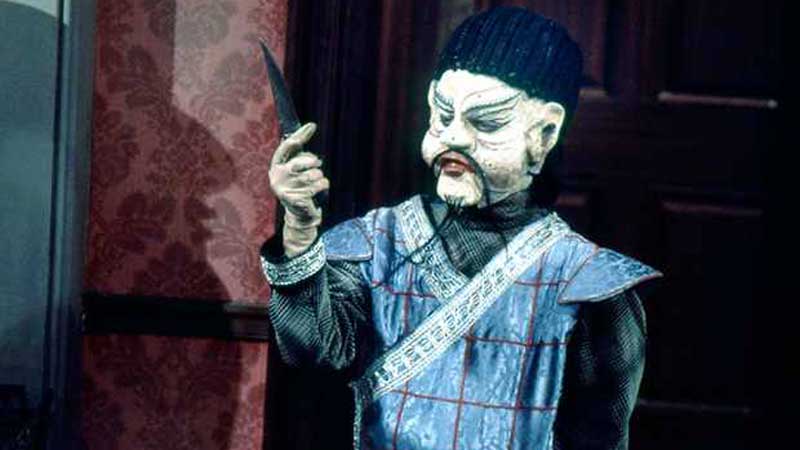
Doctor Who doesn’t get more Gothic than this. The collective macabre genius of Robert Holmes and Phillip Hinchcliffe brought us a story set in the swirling mists of 19th Century London, there are Jack the Ripper references, elements of The Face of Fu Manchu and The Phantom of the Opera and numerous nods to Arthur Conan Doyle (Tom Baker spends most of this serial in a deerstalker.)
I’ve seen ‘The Talons of Weng-Chiang’ many times, but I’m always a little fuzzy on the plot. Much like ‘The Bride of Frankenstein’, it’s a surreal melting pot of nightmarish images and bizarre characters which stay with you forever, but almost overshadow the actual story. To me, the image of Mr.Sin, a ventriloquist’s dummy (in reality a cyborg with the brain of a pig) coming to life and advancing upon Leela, knife in hand, remains one of the best and creepiest Doctor Who cliff-hangers.
7. The Maggot – The Green Death (1973)
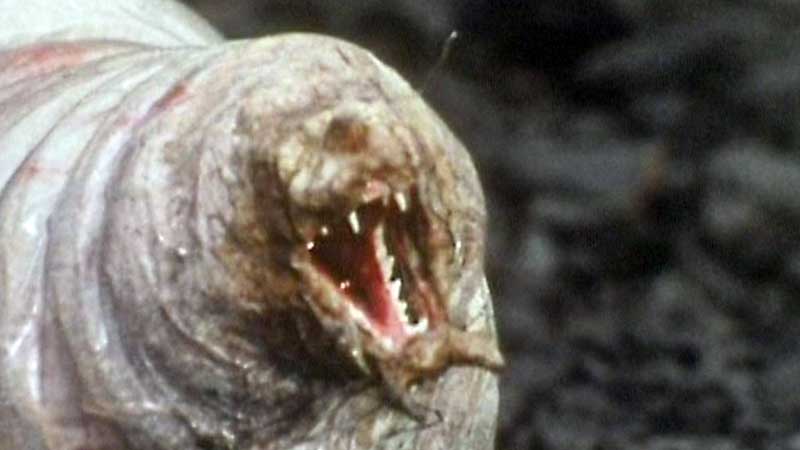
Kids love monsters, and there are few combinations of words that can get them as morbidly excited as ‘Giant Maggots’! The special effects of this serial might not stand up to the scrutiny of modern audiences, but there’s something undeniably horrible about the concept. Global Chemicals is an evil company run by a megalomaniacal self-aware computer, and its employees are all brainwashed drones.
The chemical side effect of their endeavours is a deadly green sludge, which they carelessly pump into the town’s defunct mine, resulting in death and giant maggots. The Doctor brings back a mutant egg from his expedition into the sewers, which subsequently hatches, and the scene in which its monstrous offspring crawls towards a defenceless and unaware Jo Grant is really quite frightening, and one of the most memorable episode endings of what is, personally, my favourite era of Who. What’s great about this, and most of the other classic episodes, is that was novelised by Malcolm Hulke for Target Books, immortalising what is a rather timeless story without being marred by its low-budget. (I would especially the audiobook, narrated by Jo Grant actress Katy Manning.)
6. Poisonous Gas – Resurrection of the Daleks (1984)
This one really traumatised me as a child. As Dalek stories go, this is by far one of the eeriest. Evil policemen stalk the Thames side streets of London, soldiers hide out in Butler’s Wharf and meanwhile, the Daleks are attacking a prison ship in deep space, using poisonous gas to dispatch the crew. “What IS that smell?” prison officer Osborn wonders repeatedly, before her crewmate turns to her to reveal he has been affected by the gas, his skin a mutated mess of gangrenous-looking pustules. It’s not just the gruesome make up, but his sheer pathetic helplessness as he advances on his colleague, pleading hands outstretched. “Help me! What’s happening to me?” He cries, before Osborn shoots him. Watching back now, it’s clearly intended as a mercy killing, but when I was younger I assumed she was so horrified by his monstrous appearance that she killed him out of fear. Growing up amid fears of biochemical warfare, this one gave me plenty of nightmares.
5. “Are you my mummy?” – The Empty Child (2005)
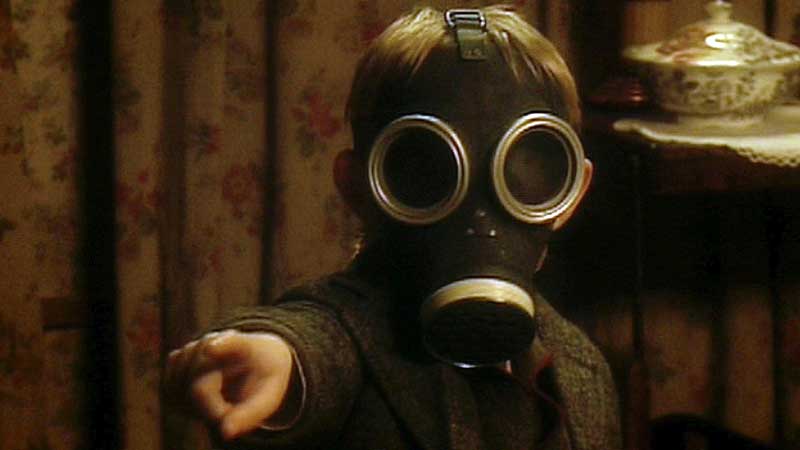
Before Steven Moffat became Doctor Who showrunner in 2010, he was renowned for writing ‘the scary ones’, and his first offering, ‘The Empty Child’, set the bar terrifyingly high. The genius of his scariest episodes was their simplicity, taking everyday items and images and reimagining them, whilst playing on basic childhood fears. In 2006’s ‘The Girl in The Fireplace’, it was The Monster Under The Bed, here it was quite simply the boy who had lost his mummy. For adults, the idea of losing their child is their worst nightmare, and all children have a fear of being lost or abandoned on some level. Wrap it up in a gas mask with one of the creepiest catchphrases in horror history and you have the makings of an iconic monster that can stand shoulder-to-shoulder with Ice Warriors and Zygons. The gas mask is no accident, either.
Genuine images of 40s children in rubber respirator masks are still somewhat seared into our national consciousness as a symbol of the suffering of innocents. The fear of war, the fear of evacuation and separation from one’s parents, and the fear of the horrors of a biochemical attack (as in No. 6) are all brilliantly realised in that one terrifying image of a dead boy in a gas mask. If the Cybermen suggest the horror of what humanity could become, The Empty Child represents the horror of what humanity has done: an innocent child victim of an adult’s war. But for all the deeper themes, simplicity is still key. As with any good horror villain, there are rules. “You mustn’t let him touch you.” Nancy warns. “He’ll make you like him. He’s empty.” It’s basically a game of Tig, albeit with fatal consequences.
4. “Do not blink!” – Blink (2007)
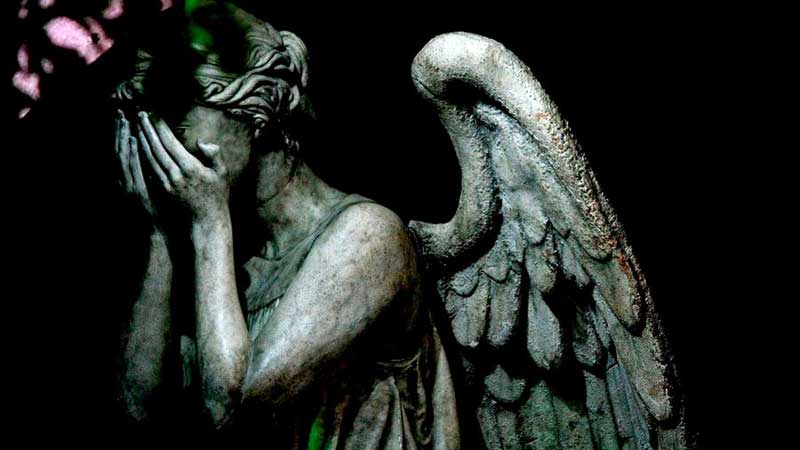
From one children’s game to another, here we have a terrifying variation on Grandmother’s Footsteps – creatures that can only move when you aren’t looking at them. With the Weeping Angels, Steven Moffat has arguably created the only 21st Century Doctor Who monster as famous and recognisable as the classics. Generally regarded as the scariest Who villains ever, it’s easy to see why. Again, it plays on a primal, childish fear – the fear of what is happening behind our back, in the dark, when we blink…
3. The Sea Devils Rising from the Water – The Sea Devils (1972)
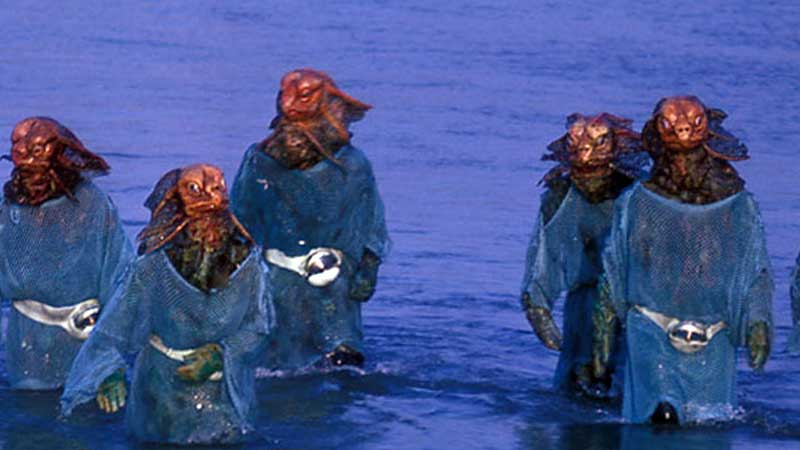
When Doctor Who is at its scariest, it gives you something you see every day and then makes it unexpectedly sinister. In this case the sea, and whatever may be hiding beneath the waves. Whilst the majority of Who monsters are aliens, the Sea Devils are natives of earth who have risen from their decades long slumber to reclaim their planet (definitely some Lovecraft influence there). Apparently, we have more detailed maps of the surface of Mars than we do of our own oceans, so the fear of what could be lurking in the deep is a very real one. I grew up on the coast, and once you’ve watched The Sea Devils as a child, you will never look at a shoreline the same way again. Each time we drove past Fleetwood Nautical College, I kept an anxious eye out for Sea Devils, and couldn’t look upon the campus without hearing Malcolm Clarke’s weird experimental electronic soundtrack. Even today I keep expecting those ragged reptilians to emerge at any moment.
2. Crushed to Death by Mummies – The Pyramids of Mars (1975)
I lied. Doctor Who does get more Gothic than ‘The Talons of Weng-Chiang’, and it’s in ‘The Pyramids of Mars’, probably the finest example of the Holmes-Hinchcliffe era of horror. Perhaps second only to ‘The Daemons’ in the blatancy of its hammer homage, particularly ‘The Mummy’ and ‘Blood from the Mummy’s Tomb’. Whilst the more recent ‘Mummy on The Orient Express’ gave us a scarier and more gruesome Mummy (and doubtless introduced a whole new generation to Universal, Hammer and Egyptian mythology), there is still something inescapably horrifying about the silent, lumbering robot Mummies of this story. Specifically, their method of killing. The scene in which Clements, a poacher, is sandwiched between two mummies and crushed to death by their bizarre barrel chests seemed such a terrifying and merciless way to go that they have always been one my most feared monsters.
1. Shop Window Dummies Come to Life – Spearhead from Space (1970)
And here it is. The absolute pinnacle of making-the-everyday-scary, and you won’t be at all surprised to hear that it was written by Robert Holmes. One can’t help but wonder if the suspicion that department store mannequins might just be twitching to life when his back was turned influenced a young Steven Moffat in the creation of the Weeping Angels. Filmed mainly on location back in 1970, the quality stands the test of time remarkably well. The Autons work so effectively because of the simplicity of their design, those terrifying waxy faces and hollow eyes. The image of dummies suddenly coming to life and smashing through shop window glass is frightening enough in itself, but they then proceed to gun down a police officer and begin an indiscriminate massacre of the people of London in one of the most violent scenes in the history of the show, and started a decades long debate on whether Doctor Who was too scary for children. It is. That’s why they like it so much.
Do you agree with our Top 10 Scariest Moments in Doctor Who? Tell us in the comments area below….








What about the Stones of Blood, and the ageing machine in the City of Death? They had a massive effect on me many, many moons ago, especially the Stones of Blood! Not sure if I want to see it again, in case my much more cynical side laughs at the SFX, rather than hide behind the sofa, watching through laced fingers….
[…] FREEMAN: I can answer the question of what sparked my interest in cryptozoology with three words, classic Doctor Who. I grew up in the 1970s when Doctor Who was at its peak with Jon Pertwee and Tom Baker. It was […]